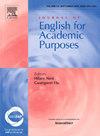Unpacking the metagenre of graphical abstracts for scientific communication
IF 3.4
1区 文学
Q1 EDUCATION & EDUCATIONAL RESEARCH
引用次数: 0
Abstract
Graphical abstracts (GAs) use multimodal representation to enhance the visibility and accessibility of research across disciplines. While increasingly common in scholarly publishing, little is known about the institutional forces that shape their production. Editorial guidelines function as a metagenre–a parent category that shapes and constrains the conventions of various genres and offers insight into how such frameworks standardize genre features while also allowing for disciplinary variation. This study conducts a metagenre analysis of GA editorial guidelines from 21 life sciences journals to understand how this metagenre is deployed to reinforce as well as modify publication practices in rhetorically strategic ways. Findings indicate that while guidelines define GAs, address the reader-oriented and paratextual purposes of GAs, and establish technical requirements, they lack guidance on the multimodal design process necessary to create compelling GAs that balance simplicity with research integrity. By providing a comprehensive metagenre analysis, this study adds to theoretical discussions of how metagenres articulate values, standardize practices, and shape social action. It also provides pedagogical and practical insights into how GA guidelines can guide individual composing processes.
解封科学传播的图形摘要元集
图形摘要(GAs)使用多模态表示来提高跨学科研究的可见性和可及性。虽然在学术出版中越来越常见,但人们对影响其出版的制度力量知之甚少。编辑指南的功能就像一个元范畴——一个形成和约束各种类型惯例的父范畴,并提供关于这些框架如何标准化类型特征的见解,同时也允许学科变化。本研究对21种生命科学期刊的GA编辑指南进行了元元分析,以了解如何以修辞策略的方式部署该元元来加强和修改出版实践。研究结果表明,虽然指南定义了GAs,解决了GAs的面向读者和文本目的,并建立了技术要求,但它们缺乏关于创建令人信服的GAs所需的多模式设计过程的指导,以平衡简单性和研究完整性。通过提供全面的元元分析,本研究增加了关于元元如何阐明价值观、规范实践和塑造社会行动的理论讨论。它还提供了关于GA指南如何指导个人作曲过程的教学和实践见解。
本文章由计算机程序翻译,如有差异,请以英文原文为准。
求助全文
约1分钟内获得全文
求助全文
来源期刊

Journal of English for Academic Purposes
Multiple-
CiteScore
6.60
自引率
13.30%
发文量
81
审稿时长
57 days
期刊介绍:
The Journal of English for Academic Purposes provides a forum for the dissemination of information and views which enables practitioners of and researchers in EAP to keep current with developments in their field and to contribute to its continued updating. JEAP publishes articles, book reviews, conference reports, and academic exchanges in the linguistic, sociolinguistic and psycholinguistic description of English as it occurs in the contexts of academic study and scholarly exchange itself.
 求助内容:
求助内容: 应助结果提醒方式:
应助结果提醒方式:


